The lift equipment category is a pivotal segment within the equipment rental industry. The impact of this sector could very well be a strong indicator of the state of rental, but what’s happening in construction in general.
Rental connected with leaders within the aerial equipment manufacturers for perspective. The following is from Tim Morris, Chief Commercial Officer at JLG.
Q. How do you see this year shaping up for the aerial market?
Construction Sector Dynamics: The construction industry has witnessed a shift towards large-scale projects, including mega sites and data centers. This transition has altered equipment requirements, prompting rental companies to adjust their fleets to meet the demand for machines that can operate in confined spaces. Consequently, there is an increased need for compact and versatile access equipment designed for space-restricted environments.
Labor Shortages and Technological Integration: Ongoing labor shortages continue to challenge the industry, leading companies to invest in training programs and automation to enhance workforce capabilities. Innovations such as the JLG ClearSky Smart Fleet IoT platform facilitate remote equipment monitoring and diagnostics, reducing the need for on-site technical interventions. Additionally, virtual reality (VR) and augmented reality (AR) tools are being adopted to efficiently upskill workers, addressing the skills gap in equipment operation and maintenance.
Despite these challenges, the North American access equipment market is projected to experience growth, albeit at a moderated pace compared to previous years.
Q. What do you think is behind this positivity?
Several sectors within the construction industry are projected to experience notable growth in the coming year, driving increased demand for access equipment:
- Residential Construction: After a period of decline, the residential sector is set to rebound, fueled by strong demand for suburban and rural housing.
- Nonresidential Construction: Growth in this sector is being propelled by significant investments in healthcare and educational facilities, as well as the expansion of data centers and technology hubs that require advanced infrastructure.
- Infrastructure Development: Government initiatives, such as the Infrastructure Investment and Jobs Act (IIJA) and the Inflation Reduction Act (IRA), will continue to spur large-scale infrastructure projects.
- Technological Integration: The adoption of augmented reality (AR), drones, modular construction, and artificial intelligence (AI) is reshaping construction practices, increasing efficiency, and addressing labor shortages.
- Sustainability and Prefabrication: A growing focus on sustainability and prefabrication is driving demand for eco-friendly building solutions and efficient construction methods.
With this surge in construction activity, rental equipment — particularly access equipment like MEWPs (mobile elevating work platforms including boom lifts, scissor lifts, low-level access lifts and vertical lifts) and telehandlers — plays a pivotal role in enabling contractors to meet project demands efficiently and cost-effectively. The flexibility and affordability of long-term rental agreements make them an attractive alternative to equipment ownership, allowing construction firms to allocate capital more strategically. 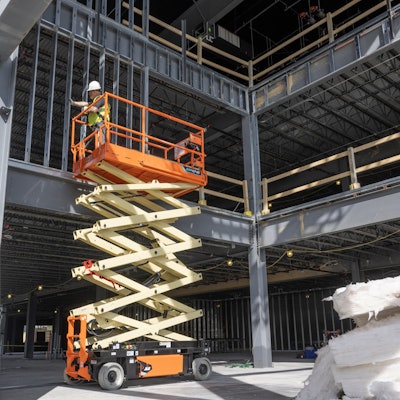 ClearSky Smart Fleet comes standard on the ES4046 Electric Scissor Lift to allow for fleet tracking.JLG Industries Inc.
ClearSky Smart Fleet comes standard on the ES4046 Electric Scissor Lift to allow for fleet tracking.JLG Industries Inc.
Q. What are your general predictions for the aerial market for 2025? What factors are contributing to this?
Overall, the aerial market, as well as the larger construction industry, seems cautiously optimistic as things are moderating. This sentiment can be attributed to fluctuations in economic conditions, causing potential slowdowns in certain construction segments, which may influence demand for certain types of rental equipment and inflationary pressures from rising costs impacting profit margins, underscoring the challenges posed by inflation. As a result, we are seeing customers make much more conscious decisions about what they purchase and who they partner with this year.
Q. How can rental stores take advantage of these factors?
With increased construction activity, the demand for rental equipment is expected to rise significantly, as long-term rental contracts offer a cost-effective alternative for construction firms seeking to minimize high capital investment costs. As long as borrowing costs remain elevated, more construction firms will choose to rent rather than buy, benefiting rental companies. This could limit equipment availability, potentially leading to increased rental rates. Additionally, government-backed infrastructure projects, which are less susceptible to interest rate hikes, will continue to drive demand for rental equipment.
By expanding their equipment offerings to include modern, high-demand equipment, including electric machines, rental companies can position themselves to take full advantage of the construction boom and drive long-term profitability.
Q. Now that electric equipment has made a solid foundation in lifting machinery, what are the biggest opportunities for growth in rental?
The rental industry’s future of electric lifting machines is promising, with significant developments driven by customer demand and technological advancements. For electric vehicles, the primary focus is on meeting customer desires for cleaner, quieter machines with zero emissions. However, challenges remain. Issues such as battery life, charging/recharging times and the ability to maintain productivity without running out of power are key considerations. The demand for electrified equipment on job sites is growing without impacting productivity, so the charging infrastructure needs to be enhanced. Also, we are addressing these considerations as we develop electrified products to meet the demands of existing duty cycles.
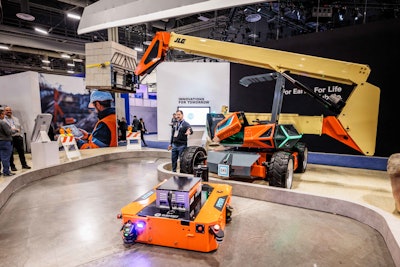 The JLG Galileo and Autonomous Mobile Charging Robot concepts as seen at CES 2025.JLG Industries Inc.
The JLG Galileo and Autonomous Mobile Charging Robot concepts as seen at CES 2025.JLG Industries Inc.
The JLG Galileo is a fully electric concept machine that combines the capabilities of a boom lift and a rotating telehandler. It was created as part of a vision of future job sites where machinery provides more versatility and efficiency. Like JLG’s all-electric DaVinci™ scissor lift and E313 telehandler, the Galileo utilizes proven design technology that eliminates hydraulics and lead-acid batteries, providing zero hydraulic leaks, zero battery replacements and zero wasted time.
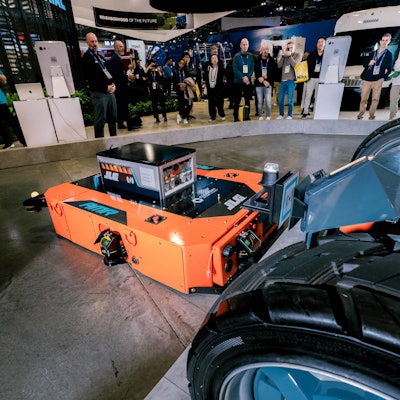 The JLG Autonomous Mobile Charging Robot concept recharging the Galileo at CES 2025.JLG Industries Inc.
The JLG Autonomous Mobile Charging Robot concept recharging the Galileo at CES 2025.JLG Industries Inc.
Working together to optimize efficiency and enhance collaboration, JLG’s Galileo-AMCR system envisions a future where connected solutions and advanced equipment address today’s industry challenges:
- Electrification & Sustainability
- Galileo operates as a fully electric machine, significantly reducing emissions and environmental impact
- The AMCR enables efficient, on-demand wireless charging, eliminating downtime and enhancing job site productivity
- Autonomy & Connectivity
- The JLG Galileo and AMCR leverage JLG’s ClearSky Smart Fleet™ technology for real-time monitoring and connectivity
- The AMCR autonomously navigates the job site, either responding to manual requests or automatically recognizing low-charge equipment and initiating charging
- Operational Efficiency & Productivity
- Galileo and AMCR reduce reliance on manual processes, which may help streamline operations and reduce potential risks of associated with manual equipment monitoring
- Automated charging ensures equipment is available and operational without human intervention
- ClearSky Smart Fleet data insights help job site managers make informed decisions on equipment utilization and workflow efficiency
- Bringing Autonomous-Driving Technology to Job Sites
- Purpose-built, route-based autonomous vehicles are ideal for construction sites with repetitive tasks and predictable routes
- An interconnected job site ecosystem features smart materials, automated maintenance, and seamless workflows
- The AMCR, after charging a piece of electric equipment, autonomously returns to its charging station to prepare for the next charging cycle
Utilizing ClearSky Smart Fleet as the foundational technology to advance and integrate autonomy, electrification and robotics, JLG’s Galileo and AMCR showcase the future, paving the way for a more efficient and sustainable construction industry. This technology has the potential to allow for more strategic deployment of people around the job site and highlight a new era of productivity where smart equipment minimizes manual intervention and maximizes efficiency.
Q. What topic(s) do you think will make the biggest/most impact in this industry? Why?
A major focus in the access equipment industry has been, and will continue to be, on integrating data and advanced technology to improve safety and efficiency.
Data Our customers face many of the same challenges that other industries face. Asset connectivity is critical. Customers want to track their machines, what they’re doing, and the type of work they’re performing.
As data collection becomes more affordable and widespread, everyone in the access equipment ecosystem — from manufacturers to rental companies and end-users — can leverage this shift by gathering more detailed information into machine usage and performance. This influx of data can provide actionable insights to optimize fleet management and maintenance, informing future decisions based on real-world trends.
Advanced Technology
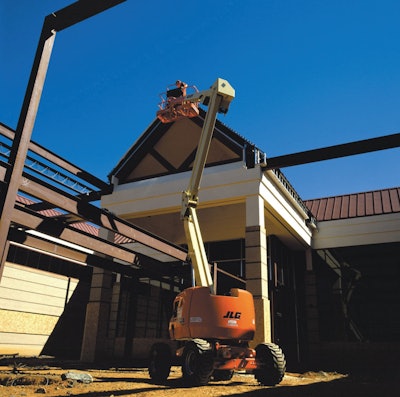 The 45-ft. platform-height 450AJ Boom Lift features a larger work envelope on both jib and non-jib models as well as extended reach.JLG Industries Inc.
The 45-ft. platform-height 450AJ Boom Lift features a larger work envelope on both jib and non-jib models as well as extended reach.JLG Industries Inc.
The hunt for autonomous machines and technologies is not new. The biggest driver in advancing autonomy and robotics in access equipment is the constant need to improve productivity, streamline repetitive processes and reduce operating costs. Robotic technology can handle repetitive tasks faster and at a more consistent level of quality.
At JLG, we look for forward-thinking and innovative organizations that, like us, aim to make job sites safe and efficient. We seek out innovation, no matter where it originates, and foster partnerships that drive progress. When we find such organizations, we collaborate with them to combine our strengths and expertise. This is why you’ve seen us working alongside companies like Construction Robotics, who share our vision.
In our work with Construction Robotics (CR), we have supplied two machines for integration with CR’s new battery-powered compact MZ100 Material Unit Lift Enhancer (MULE): a JLG RT3394 scissor lift and a Hinowa TPX4000 tracked pallet jack (also known as a forklift). This initiative aims to use robotics on machines commonly used by masonry and concrete contractors to lift and place concrete blocks. This cumbersome, repetitive construction task often results in cumulative injury. Our commitment to this project does not stop there. We continue collaborating closely with CR to refine their products further. We aim to ensure these advanced systems are perfected and ready for market deployment. By doing so, we strive to provide our customers with solutions that elevate safety and efficiency standards in the construction industry. For example, we have also launched an adapter that integrates the CR MZ100 MULE with a JLG RT3394 scissor lift, which provides both operation at adjustable heights and mobility to the robotic arms.
Adopting new technologies and solutions, like robotics and autonomy, to complete work at height will be crucial in reshaping the landscape of construction work.
Q. What are the biggest changes at JLG? How is JLG adapting to 2025?
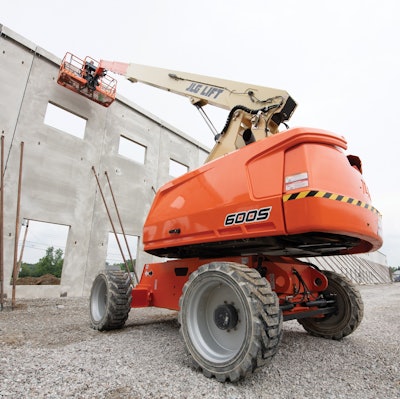 600 Series telescopic boom lifts have a powerful combination of performance and reliability to allow contractors the capability to conquer all their worksite challenges.JLG Industries Inc.
600 Series telescopic boom lifts have a powerful combination of performance and reliability to allow contractors the capability to conquer all their worksite challenges.JLG Industries Inc.
Q. What’s on the horizon for JLG?
There is excitement around JLG’s recent acquisitions of the AUSA and Hinowa brands, as these bring additional products to support work at height. These acquisitions expand JLG’s product offerings, allowing the company to serve a broader range of customers’ needs.
Additionally, the new EC600AJ boom lift, which was introduced at World of Concrete and goes into production later this year, has generated a lot of excitement pre-launch. Integrating Oshkosh electrification technology used in mail delivery vehicles, this new model adapts it for use in the construction and equipment rental markets. As electrification continues to grow, JLG’s ability to shift between IC (Internal Combustion) and EC (Electric) power, depending on the specific needs of the job site, in these new boom lifts makes them versatile and well-suited to various work environments. This combination of advanced technology and adaptability to electrification trends makes these products particularly exciting for the market.
View the original article and our Inspiration here

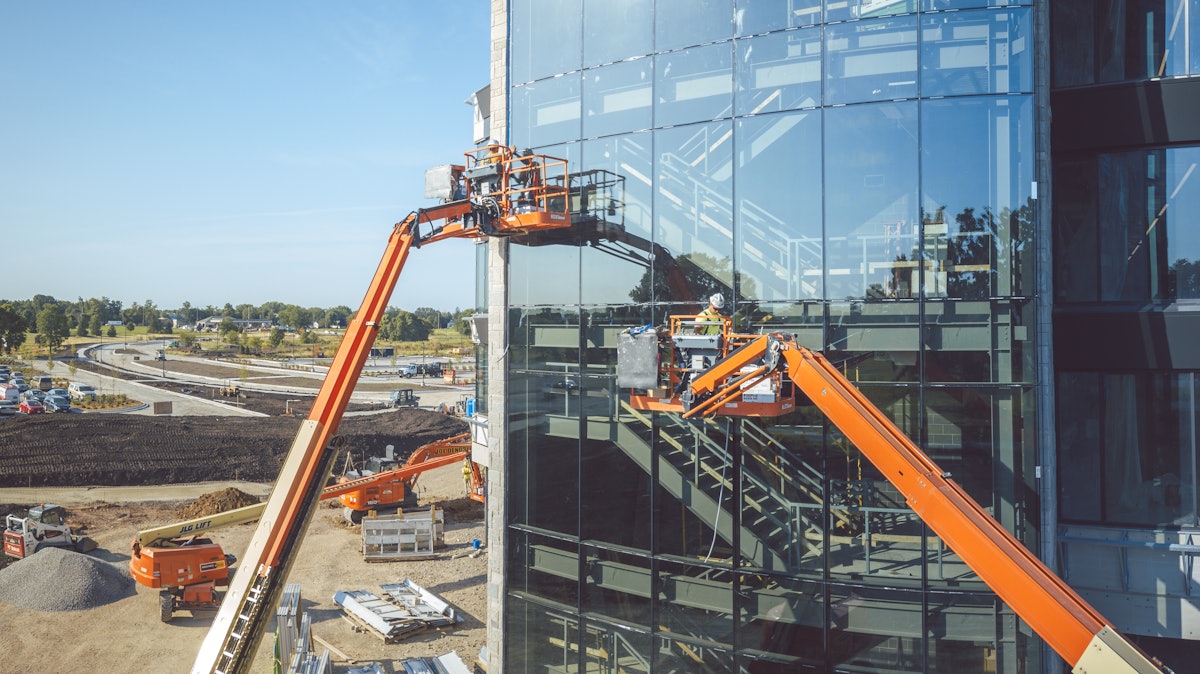
Leave a Reply